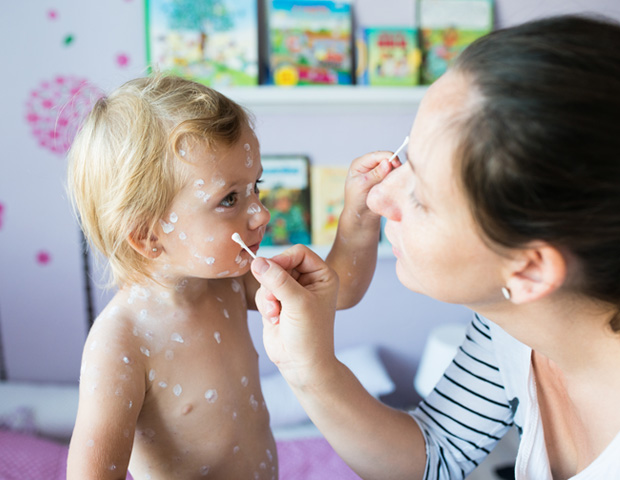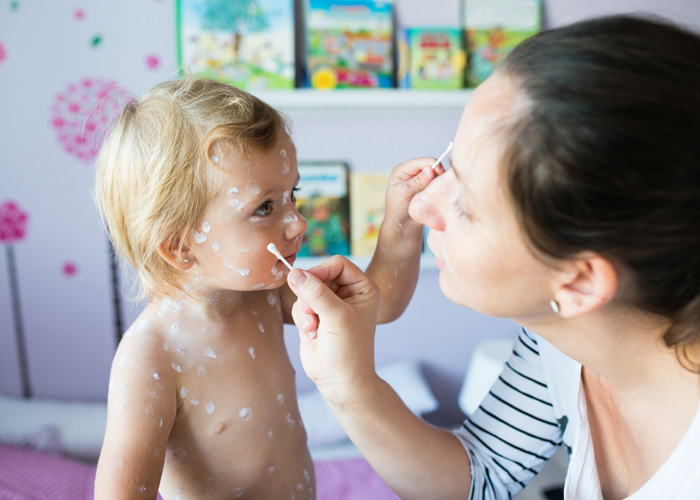In OTC
Follow this topic
Bookmark
Record learning outcomes
Childhood eczema is so common that it’s easy to believe parents know how to manage it. This is not necessarily true, however, and there is plenty the pharmacy team can do to help
According to the National Eczema Society (NES), atopic eczema affects 20 per cent of children in the UK, causing dry, red and itchy skin. Mild eczema can often be managed in primary care with emollients and lifestyle changes, such as avoiding soap and other common irritants, but around one in 20 children with eczema have more severe symptoms that require prescribed treatments. Uncontrolled eczema can have a huge impact on a child’s quality of life, with persistent itching and sore skin leading to sleepless nights, difficulty concentrating and days off school.
Children with severe eczema may feel embarrassed about how their skin looks, leading to low self-esteem and evenclinical depression. Cetraben, in partnership with the British Skin Foundation, recently released a suite of images presenting the realities of eczema and the real people behind the condition. The brand campaign, called This is my skin, features models with eczema, psoriasis and other dry skin conditions. Its aim is to show that these conditions are a natural part of everyday life for 16.8 million people in the UK, raising awareness, educating the public and removing stigma.
Advice for parents
According to pharmacist Sultan Dajani, community pharmacists are well placed to provide eczema management advice to parents of children affected by the condition. “It is important to assess the child’s skin and investigate the patient history and previously used treatments,” he says. “Pharmacists can offer emollients over the counter, but do make parents aware of theemollient ranges that are available on prescription. Findings from a recent Epaderm Junior study show that over 65 per cent of parents bought an emollient over the counter before visiting a healthcare professional, and 74 per cent said they would benefit from receiving information from pharmacists about emollient application. A pharmacist could go the extra mile by offering a dermatology review, either weekly or fortnightly, to see if thechild’s skin is worse or better.”
Emollients are the mainstay of daily eczema management, even in severe cases. They should be applied liberally and frequently during the day, and also after a bath or shower. Complete emollient therapy involves using soap substitutes and emollient bath and shower products as well as creams, lotionsand ointments.
“When applied regularly, emollients restore the skin barrier and protect it from environmental insults, reducing the risk of flares,” says Dr Zainab Laftah, consultant dermatologist and British Skin Foundation spokesperson. “There are a number of emollients on the market, and their consistency varies depending on their oil to water content. The higher the oil content, the greasier the emollient and the greater the moisturising effect.”
Consultant dermatologist Dr Kathy Taghipour says that different emollients will suit different people. “Allow the child to use the one they prefer as they are more likely to continue using it,” she says. “All emollients should be SLS-free and fragrance-free so as not to trigger any allergies. If the skin is very dry, a rich, paraffin-based emollient will work well. If the skin is less dry, lighter emollients such as creams are sufficient. Different emollients can also be used for different times of the day – for example, lighter emollients for daytime and during active hours and greasier ones for night-time.”
Several brands offer emollients for daily use alongside those for use during eczema flare ups. In a recent study conducted by Eucerin, 692 participants with atopic eczema applied Eucerin AtoControl Lotion (daily emollient) and AtoControl Acute Care Cream (for flare ups) twice daily, over a period of two weeks during a flare up. Dermatologists found a 48 per cent reduction in itching intensity after two weeks, and a 61 per cent reduction in local SCORAD (severity scoring of atopic dermatitis) intensity. Dr Felton says that moderate to severe eczema may need prescribed treatments as well as daily emollients. “If eczema is causing distress to the parents or their child, affecting sleep, concentration or attendance at school or nursery, they should seek help,” she says. “If there is a sudden worsening of eczema, this can indicate an infection, and the child should be reviewed by a doctor.”
Children may be prescribed a topical corticosteroid to use during a flare up or occasionally between flare ups. It is important that parents apply only a small amount, according to the doctor’s instructions. They should ideally apply the emollient first, then wait around 15 to 30 minutes before applying the steroid. “A fingertip unit (steroid covering the length of their index fingertip) is the amount required to cover an area equivalent to two palms,” says Dr Laftah. “When used appropriately, steroids are safe and effective.”
When applied regularly, emollients restore the skin barrier and protect it from environmental insults, reducing the risk of flares
Free pharmacy learning
Thornton & Ross has created a free Care-branded app for healthcare professionals, which includes advice for pharmacists on choosing the right emollients for customers. Also, for its Cetraben brand, the company offers a free, CPD-certified educational programme, the Skintelligence Academy, which is approved by the British Skin Foundation and helps healthcare professionals refresh and improve their knowledge of key dermatology topics. Modules can be requested here.
Improving compliance
Emollients will only work properly if they are applied regularly and generously. To help parents make sure they are using enough, Bioderma has developed a ‘3-6-9’ application method with dermatologists, which outlines the most effective way to apply emollient – how many pumps of Atoderm Intensive Balm or Atoderm SOS Spray to use for babies (three pumps), children (six pumps) and adults (nine pumps), and where on the body. A daily management routine is essential, but parents may find that children and teenagers struggle to comply. “Applying creams and products can be seen as annoying and disruptive by small children, for example when the cream is cold or rubbing off on their clothes and belongings,” says child behaviourist Richard Daniel Curtis. “Ultimately, by the time children mature, we want them to be taking responsibility for treating their own eczema, whether this is using the right emollients, bath productsor shampoos. Moisturising should be an automatic thing for them, and you want it to be a habit rather than a chore.”
If eczema management becomes a battleground, parents should try to encourage their children to take a more active role. Dr Taghipour recommends the EmolliZoo app by Dermal Laboratories, in which children help a zookeeper look after eczema in various animals and receive rewards and stickers if they follow a good emollient routine. Other useful tips include:
- Turn it into a game, such as who’s going to rub their cream in first
- Use a star chart with rewards to aid motivation and give a positive sense of achievement
- Teach older children to apply emollient when they feel itchy and to pat the area gently rather than scratch
- Parents should warm up the emollient to skin temperature in their hands before applying it
- Apply emollients in the direction of hair growth to avoid blocking hair follicles and causing spots.
Handwashing tips
 The British Association of Dermatologists has warned that washing hands with emollients may not be as effective as using soap for removing coronavirus. The National Eczema Society is therefore recommending that people with eczema follow Government guidance and wash their hands with soap and water. However, they should also then re-wash their hands with an emollient and use emollients to moisturise their hands after washing. Additional tips that you can pass on to customers include:
The British Association of Dermatologists has warned that washing hands with emollients may not be as effective as using soap for removing coronavirus. The National Eczema Society is therefore recommending that people with eczema follow Government guidance and wash their hands with soap and water. However, they should also then re-wash their hands with an emollient and use emollients to moisturise their hands after washing. Additional tips that you can pass on to customers include:
- Always moisturise with a non-fragranced hand cream after washing
- Dry hands well after washing by gently patting them, rather than rubbing
- Rehydrate sore dry hands overnight by applying a rich emollient and wearing clean cotton gloves
- Wear gloves when cleaning or washing up to protect hands from irritants and chemicals
- Customers whose hands are itchy, cracked or bleeding should contact their GP.
Identifying triggers
Understanding a child’s eczema triggers and how to avoid them is another important aspect of eczema management. In September 2019, Thornton & Ross (owner of the Oilatum brand) conducted a survey of 1,000 UK mums with at least one child under 10 with dry skin and/or eczema. The research found that 41 per cent of respondents believed certain skincare or bodycare products or ingredients could trigger their child’s dry skin or eczema, and 14 per cent had run a hot bath in a bid to calm their child’s skin, unaware that this can in fact make it worse.
Paediatric dermatologist Dr Jess Felton says environmental triggers are particularly common. “Reducing house dust mites by damp dusting, regular vacuuming and washing bedding at 60°C can be helpful,” she says. “Unfortunately, furry pets are not advised in an eczema-prone household, particularly cats. Some children find their eczema is triggered by pollen. Taking a prescribed antihistamine, and measures such as not drying bedding outside in the spring and summer can reduce reactions. Other triggers include viral infections, teething and stress. Children with eczema often feel itchier when hot, so having a cooler bedroom (as long as their body temperature feels fine) can often help.”
If parents need extra advice and support, you could direct them to patient information/support websites. These include:
- National Eczema Society
- British Association of Dermatologists
- Nottingham Support Group for Carers of Children with Eczema.
Views from the P3pharmacy category panel
Selina Gill Rowlands Pharmacy, Redditch
“Skin care is one of the most popular areas within the pharmacy as it is so varied. Patients often seek advice for atopic eczema, sun protection, allergic dermatitis and support for managing psoriasis. Aveeno is always a popular choice, with a vast range of products marketed to showcase its natural oat derivatives; patients often feel secure in their Aveeno product selection. Prescribing restrictions on emollients has caused a flood of sales; we have also seen a marked increase in aesthetic skin queries and I can see further growth in this area.”
Marisa Maciborka Bedminster Pharmacy
“We don’t find skin care a particularly important category, unless it’s customers who want advice on treating a troublesome skin condition. This might be for a problem such as acne. We are typically asked about how to reduce oiliness and spots, and about treating very dry skin. Best sellers include Acnecide, the Neutrogena range, Dove products, Doublebase and Cetraben. I’ve noticed that people want fewer chemicals and more gentle treatments for their skin. We organise displays based on skin type and skin condition.”
Lindsey Fairbrother Goodlife Pharmacy, Hatton, Derbyshire
“This is an important and popular category for us, but there are now so many products it can be difficult to keep up to date with them all. We treat a wide range of conditions, from children with a skin rash to adults with severe psoriasis. Queries range from how to treat insect bites in summer, and eczema and dry skin questions all year round. During the pandemic, we’ve had a lot of queries about how to treat dry hands due to all the hand washing, so hand cream has been very popular. Oilatum does really well for us, as do Aveeno and E45.”


